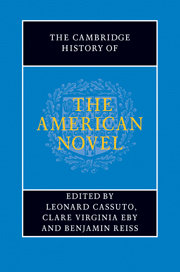Book contents
- Frontmatter
- General Introduction
- PART ONE INVENTING THE AMERICAN NOVEL
- Introduction: inventing the American novel
- 1 Transatlantic currents and the invention of the American novel
- 2 Susanna Rowson, Hannah Webster Foster, and the seduction novel in the early US
- 3 Charles Brockden Brown and the novels of the early republic
- 4 The novel in the antebellum book market
- 5 American land, American landscape, American novels
- 6 Cooper and the idea of the Indian
- 7 The nineteenth-century historical novel
- 8 Hawthorne and the aesthetics of American romance
- 9 Melville and the novel of the sea
- 10 Religion and the nineteenth-century American novel
- 11 Manhood and the early American novel
- 12 Sentimentalism
- 13 Supernatural novels
- 14 Imagining the South
- 15 Stowe, race, and the antebellum American novel
- 16 The early African American novel
- PART TWO REALISM, PROTEST, ACCOMMODATION
- PART THREE MODERNISM AND BEYOND
- PART FOUR CONTEMPORARY FORMATIONS
- A selected bibliography
- Index
12 - Sentimentalism
from PART ONE - INVENTING THE AMERICAN NOVEL
Published online by Cambridge University Press: 28 July 2011
- Frontmatter
- General Introduction
- PART ONE INVENTING THE AMERICAN NOVEL
- Introduction: inventing the American novel
- 1 Transatlantic currents and the invention of the American novel
- 2 Susanna Rowson, Hannah Webster Foster, and the seduction novel in the early US
- 3 Charles Brockden Brown and the novels of the early republic
- 4 The novel in the antebellum book market
- 5 American land, American landscape, American novels
- 6 Cooper and the idea of the Indian
- 7 The nineteenth-century historical novel
- 8 Hawthorne and the aesthetics of American romance
- 9 Melville and the novel of the sea
- 10 Religion and the nineteenth-century American novel
- 11 Manhood and the early American novel
- 12 Sentimentalism
- 13 Supernatural novels
- 14 Imagining the South
- 15 Stowe, race, and the antebellum American novel
- 16 The early African American novel
- PART TWO REALISM, PROTEST, ACCOMMODATION
- PART THREE MODERNISM AND BEYOND
- PART FOUR CONTEMPORARY FORMATIONS
- A selected bibliography
- Index
Summary
In an 1867 New York Ledger article, Fanny Fern observed: “at this day it is dificult to find [a woman] who does not write, or has not written, or who has not, at least, a strong desire to do so.” A quick glance at the names of authors, especially the bestselling ones in the years leading up to and following the Civil War, proves her point: Susan Warner, Maria Cummins, E. D. E. N. Southworth, Mary Jane Holmes, Caroline Lee Hentz, Elizabeth Stuart Phelps, and, of course, Harriet Beecher Stowe. Their output was remarkable. Southworth, for example, wrote more than sixty novels, Holmes almost forty, and even the less prolific ones were nonetheless quite productive. The entire body of sentimental novels numbers in the many hundreds.
This enormous archive has, for all intents and purposes, been distilled for reasons both pragmatic and problematic into a representative twosome, with Stowe's Uncle Tom's Cabin (1852) and Warner's The Wide, Wide World(1851) standing in for the genre known as the sentimental novel. Despite the distinctive aspects of individual novels (features upon which I shall elaborate in this chapter), whether at the level of plot, ideology, or aesthetics, the category of sentimentalism and its general features have nevertheless been extremely useful to literary critics. These features include a focus on day-today activities in the domestic sphere, a concentration on relationships, and a profound interest in the emotional lives of women. With the publication of F. O. Matthiessen's American Renaissance (1941), which ushered in the academic study of nineteenth-century American literature, sentimentalism stood as the dividing line between high and popular literature, between male and female writers, between serious and maudlin representations of American life in literature.
- Type
- Chapter
- Information
- The Cambridge History of the American Novel , pp. 209 - 220Publisher: Cambridge University PressPrint publication year: 2011
- 1
- Cited by



